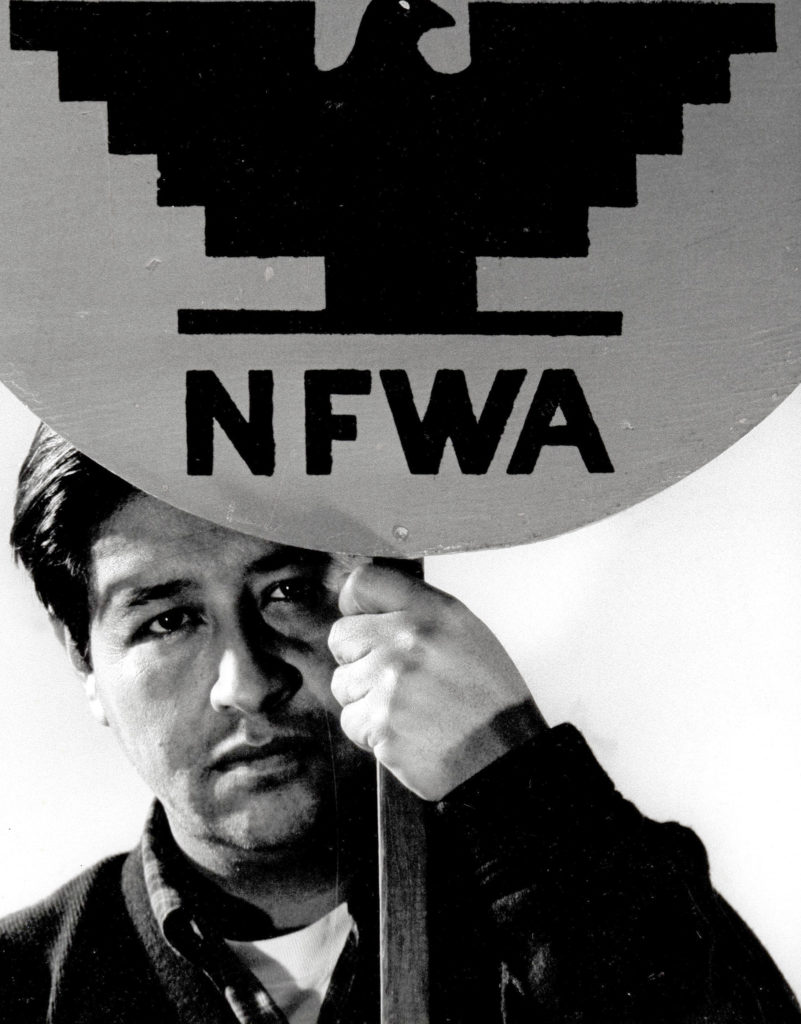Easy Essay: Cesar Chavez ∼ 25-Years and Counting by LeRoy Chatfield
CESAR CHAVEZ 1965 / Photo by Jon Lewis
Cesar Chavez 1927-1993
25-Years and Counting
By LeRoy Chatfield
On April 23, 2018 Cesar Chavez had been dead and buried now 25-years . . . and counting. “Counting” because his legacy lives on seemingly without end and the next 25-years will tell us whether or not he will be memorialized with a national holiday, taking his place alongside Martin Luther King, Jr. Abraham Lincoln and George Washington.
As of this writing – April 2018 – I count 116 Cesar Chavez public memorials in California, Arizona, Colorado, Michigan, New Mexico, Texas, Wisconsin and Utah and this does not count the USPS memorial postage stamp, the USNS Cesar Chavez cargo ship and the U.S. Park Service “National Chavez Center’ in Keene California.
I take a deep breath before I dare write this: After the death of Cesar Chavez in 1993, more public memorials have been created to honor his memory than for any other citizen in the 168-year history of California. I believe this statement to be true but welcome any documentation to the contrary and will yield to its proof.
On its face, it seems inconceivable that a person born into an impoverished migrant farm worker family, re ceiving little formal education – Chavez told me he counted 28-elementary schools he attended during his childhood – enlisting in the U.S. Navy at the age of 17-years to serve two-years, then recruited and trained to work for the Community Service Organization (CSO) – a Mexican American organization in San Jose, California founded to help its members with voter registration and voter participation, to counteract housing and job discrimination against Mexican Americans and to cope with the all-too-many examples of police brutality directed against Mexican American communities in California. So successful was his work, he rose through the CSO ranks to become its state director until he resigned in 1962 to found his own community service organization, the National Farm Workers Association (NFWA) for the purpose of organizing farmworkers to fight for social justice and union recognition from the California table grape growers in Fresno, Tulare and Kern counties.
Chavez founded and built his farmworker movement – chartered by the AFL- CIO in 1966 as United Farm Workers of America – from 1962, the year of its founding, until 1993, the year of his death at the age of 66-years. He was married 45-years to Helen Fabela Chavez, the father of eight children and the grandfather of thirty-one grandchildren.
Without doubt Chavez lived a life of service to the immigrant poor but does this qualify him to now be the most memorialized Californian in history? What would motivate people in eight states to hold him in such high honor? Certainly, throughout its 168-years, other Californians have lived a life of service to others but have not been so honored. Why Cesar Chavez?
The issue, as I see it, is not what Cesar Chavez accomplished – or failed to accomplish – during his 66-years, but what was it about his persona, his being, and what he stood for, that made such an impression upon millions of others.
Chavez made famous this saying: when you do not know what to do or what the answer is, go out and talk to the people, they will tell you! Yes, it’s true! I myself have had this experience . . . the people will tell you.
Dozens of books have been written, documentary and feature films have been created, theatre plays and musicals have been performed, muralists have covered walls throughout the state, academics have poured over the 31-year history of Cesar Chavez and his farmworker movement and have documented and dissected his life of achievements, his short comings and of course, his failures . . . but none of this explains why Chavez is the most memorialized Californian in history!
Why, you ask? Because no one – not even one person – has “asked the people”. They are the only ones who can explain to us why the legacy of Cesar Chavez marches far into future generations with no end in sight.
The people I refer to are those who are organizing the powers-that-be to rename schools, university buildings, city parks and plazas, major roads, libraries and commissioning statues and murals – none of these Cesar Chavez public memorials happen accidentally; it takes a ground swell of large number of organized people to make this happen, it takes tenacity and a lot of Si Se Puede! It takes a long time to accomplish!
Before it is too late – people pass away, memories fail – who will take up the challenge to “talk to the people” and explain to us why Cesar Chavez is held in such high esteem 25-years after his death?
(LeRoy Chatfield and Cesar Chavez were close friends and colleagues 1963-1973)

